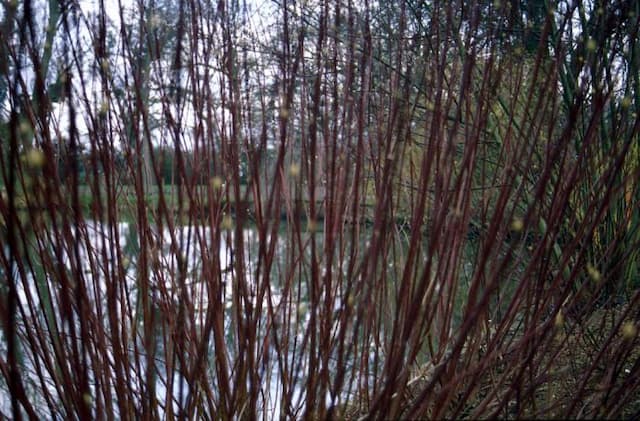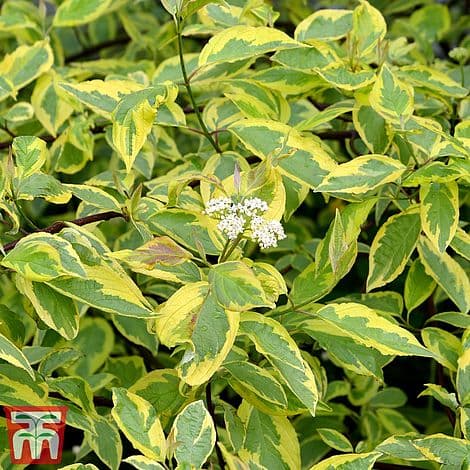Wedding Cake Tree Cornus 'Norman Hadden'

ABOUT
The Cornus 'Norman Hadden', also known as the Flowering Dogwood, is a striking plant that stands out with its gorgeous floral display and attractive form. It boasts an array of creamy white flowers that give it a festive look during its blooming season. The flowers have a unique structure, with each individual flower surrounded by four large, showy bracts that are often mistaken for petals due to their petal-like appearance. The leaves of the Flowering Dogwood have an oval shape and a lush green color that provides a beautiful contrast to the white flowers. As the seasons change, the foliage undergoes a dramatic transformation, shifting to vibrant shades of red and purple, which adds a burst of color to the landscape in the fall. The bark of this plant is an interesting feature as well; it has a mottled texture that is greyish to brown in color, which becomes more pronounced as the plant matures. The texture of the bark adds another dimension of interest, particularly in the winter months when the leaves have fallen and the structure of the plant is more visible. Additionally, the Flowering Dogwood produces berry-like fruits which are a deep shade of red. These fruits are a valuable food source for birds and increase the wildlife appeal of the plant. However, they also contribute to the ornamental value of the Cornus 'Norman Hadden', as the red fruits stand out against the backdrop of the branches. Overall, the Flowering Dogwood is known for its four-season appeal, with spring flowers, elegant summer foliage, bright fall color, and textured winter bark. The beauty of this plant is seen in its flowering bracts, the seasonal color changes of the leaves, the distinctiveness of its bark, and the ornamental fruits that grace its branches.
About this plant
 Names
NamesFamily
Cornaceae.
Synonyms
Norman Hadden Cornus, Norman Hadden Dogwood, Norman Hadden Flowering Dogwood.
Common names
Cornus 'Norman Hadden'.
 Toxicity
ToxicityTo humans
The Cornus 'Norman Hadden', commonly known as the Flowering Dogwood, is not known to be toxic to humans. It is generally considered to have a low level of toxicity and is not expected to cause serious harm if ingested. Eating large quantities of any part of the plant may cause discomfort or stomach upset due to the presence of saponins and other plant compounds, but it is not expected to cause significant toxicity or serious health consequences.
To pets
The Flowering Dogwood has a low level of toxicity to pets. It is not typically known to be poisonous to dogs or cats, and ingestion of small quantities is unlikely to cause more than mild gastrointestinal upset, such as vomiting or diarrhea. However, it is always recommended to prevent pets from eating plants, as individual animals might have different sensitivities, and consuming large amounts can lead to more significant digestive discomfort.
 Characteristics
CharacteristicsLife cycle
Perennials
Foliage type
Deciduous
Color of leaves
Green
Flower color
White
Height
20 feet (6 meters)
Spread
15 feet (4.5 meters)
Plant type
Tree
Hardiness zones
5
Native area
China
Benefits
 General Benefits
General Benefits- Ornamental Appeal: Cornus 'Norman Hadden' produces showy floral displays, with white flowers that attract attention in spring and summer.
- Fall Foliage: It offers colorful autumn foliage, often in vibrant shades of red and purple, enhancing the seasonal landscape.
- Wildlife Attraction: The plant provides nectar for bees and butterflies, as well as fruits for birds, supporting local wildlife.
- Drought Tolerance: Once established, it is relatively drought-tolerant, requiring less watering compared to other garden plants.
- Low Maintenance: It generally requires minimal pruning and upkeep, making it suitable for gardeners seeking low-maintenance options.
- Erosion Control: Its root system can help prevent soil erosion, making it useful for planting on slopes or banks.
- Versatile Landscaping: The plant can be used for various landscaping purposes such as specimen planting, hedging, or in mixed borders.
 Medical Properties
Medical PropertiesThis plant is not used for medical purposes.
 Air-purifying Qualities
Air-purifying QualitiesThis plant is not specifically known for air purifying qualities.
 Other Uses
Other Uses- Cornus 'Norman Hadden' can be used in woodworking crafts due to the hardness and durability of its wood, which can be turned to make small objects like tool handles or artisanal wooden toys.
- The tree's branches and twigs can be harvested for use in floral arrangements, providing a unique texture and shape that is often sought after by florists.
- The fruit of the Cornus 'Norman Hadden', though not widely consumed, can be used in small quantities to make jellies or jams that offer a unique flavor to adventurous culinary enthusiasts.
- Foliage from the Cornus 'Norman Hadden' can serve as a natural dye, with leaves and bark producing shades of blue or green when processed and applied to textiles.
- The plant's dense growth habit can provide shelter and nesting sites for various species of birds, making it a valuable addition to wildlife gardens.
- In photography, the striking form and flowers of the Cornus 'Norman Hadden' can be used as an appealing subject for nature photography.
- The tree can be strategically planted in landscapes to provide shade in small garden areas, thanks to its broad canopy.
- Its attractive bark texture and pattern can be used as inspiration for artists and designers, leading to its incorporation in patterns for fabrics, wallpaper, or graphic art.
- The Cornus 'Norman Hadden' can be incorporated into bonsai practices, where its growth can be trained and maintained in miniature form as an artistic endeavor.
- Leaves of the Cornus 'Norman Hadden' may be used in craft projects for children, such as leaf rubbing art, due to their pronounced veining that creates clear and beautiful patterns.
Interesting Facts
 Feng Shui
Feng ShuiThe Dogwood is not used in Feng Shui practice.
 Zodiac Sign Compitability
Zodiac Sign CompitabilityThe Dogwood is not used in astrology practice.
 Plant Symbolism
Plant Symbolism- Transformation - The Cornus 'Norman Hadden' (often associated with various types of dogwood flowers) symbolizes change and transformation, reflecting the plant's own life cycle and its capacity for renewal and rebirth each year.
- Endurance - Dogwoods are known for their hardy nature and ability to withstand challenging conditions, making them a symbol of strength, resilience, and the ability to endure hardships.
- Purity - The delicate white flowers of the Cornus 'Norman Hadden' are often associated with purity and innocence, similar to other white blooming plants, connected with themes of cleanliness and virtue.
- Faith - In Christian symbolism, the dogwood is often connected with faith and Christianity, with the structure of the flower tied to elements of the crucifixion of Jesus, making it a symbol of unwavering faith.
- Love undiminished by adversity - Due to its resilience and year-round beauty, the dogwood can represent love that remains strong even when faced with challenges.
 Water
WaterThe Wedding Cake Tree (Cornus 'Norman Hadden') should be watered deeply, ensuring that the water reaches the roots, about once a week during its growing season. Newly planted trees require more frequent watering, about twice a week, until they establish a strong root system. During the hot summer months, increase watering frequency to accommodate for faster soil drying, ensuring the tree receives about 1 to 1.5 inches of water per week. In the fall and winter, reduce watering as the tree requires less moisture when dormant. Always check the soil moisture level before watering to prevent overwatering; the soil should be moist but not waterlogged.
 Light
LightThe Wedding Cake Tree thrives in a spot that receives full sun to partial shade. It can benefit from some afternoon shade in areas with particularly hot summers, but overall, it prefers bright and direct light. A location with morning sunlight and some protection from the harsh midday sun is ideal to maintain the vibrant colors of its leaves and facilitate healthy growth.
 Temperature
TemperatureThe Wedding Cake Tree is hardy and can survive in a range of temperatures; however, it prefers temperate climates. It can endure minimum winter temperatures down to about -20 degrees Fahrenheit, while in summer, it can tolerate heat up to 95 degrees Fahrenheit. The ideal temperature range for this tree is between 60 and 75 degrees Fahrenheit to ensure optimal growth and flowering.
 Pruning
PruningThe Wedding Cake Tree should be pruned to maintain its shape, remove dead or diseased wood, and promote healthy growth. Light pruning is best done in late winter or early spring before the new growth starts. Regular pruning is not extensive, but just enough to maintain its desired form and remove any rubbing or crossing branches.
 Cleaning
CleaningAs needed
 Soil
SoilThe Cornelian Cherry Dogwood (Cornus 'Norman Hadden') thrives in well-drained, fertile soil enriched with organic matter. For optimal growth, use a mix of loam, peat, and sand in equal parts. This soil combination retains moisture yet allows excess water to drain away, preventing root rot. The ideal soil pH for this plant should be slightly acidic to neutral, ranging between 5.5 and 7.
 Repotting
RepottingThe Cornelian Cherry Dogwood does not require frequent repotting as it is typically grown as an outdoor shrub or small tree. It may only need repotting or transplanting if it outgrows its current space or if it's being grown in a container. In such cases, repotting every 2 to 3 years should suffice, ideally during the dormancy period in late fall to early spring.
 Humidity & Misting
Humidity & MistingThe Cornelian Cherry Dogwood naturally adapts to a wide range of humidity levels and does not have stringent humidity requirements. Ambient outdoor humidity typically suffices, but it can tolerate some dryness. Therefore, while specific humidity levels aren't crucial, average garden conditions usually provide adequate humidity for this plant to thrive.
 Suitable locations
Suitable locationsIndoor
Grow in bright, indirect light, keep soil moist, not soggy.
Outdoor
Plant in sun to part-shade, mulch well, shelter from harsh winds.
Hardiness zone
5-9 USDA
 Life cycle
Life cycleCornus 'Norman Hadden', commonly known as Flowering Dogwood, begins its life as a seed, typically dispersed by wildlife after consuming its fruit. The seed germinates in favorable conditions of moist soil and partial shade, developing a root system and a shoot that emerges as a seedling. As the seedling grows, it develops into a juvenile tree, with leaves expanding to collect sunlight for photosynthesis, driving further growth. After several years, it matures and starts to bloom, producing showy flowers in the spring, which are actually bracts surrounding the true small flowers. Following pollination by insects, these flowers develop into fruit, which ripen by late summer or fall and are eaten by birds, who then disperse the seeds. The Flowering Dogwood continues this cycle, growing and expanding its canopy, for many years, often several decades, completing its life cycle when it dies either due to age, disease, or environmental factors.
 Propogation
PropogationPropogation time
Spring-Early Summer
The Cornus 'Norman Hadden', commonly known as the Flowering Dogwood, is typically propagated by softwood cuttings during late spring or early summer when the plant is actively growing. The most popular method begins with taking 4 to 6 inch (10 to 15 cm) cuttings from new growth, ensuring at least two or three sets of leaves are present. The lower leaves are removed, and the cut end of the cutting is dipped in a rooting hormone to facilitate root development. The treated end is then placed in a moist, soilless potting mix, ensuring that at least one set of leaf nodes is buried. The pot is then placed in a bright, indirect light area and covered with plastic to maintain high humidity. Rooting can take several weeks, after which rooted cuttings can be transplanted into individual pots to grow on before being moved to a permanent location outdoors.









